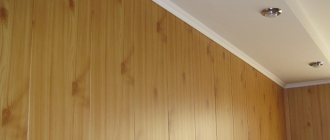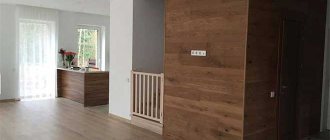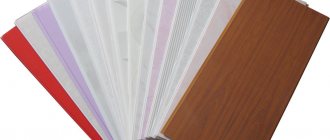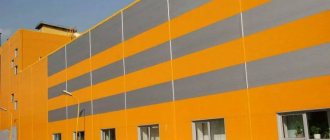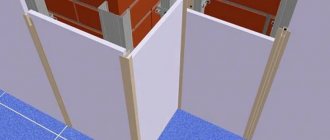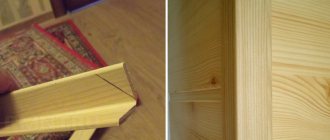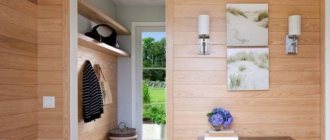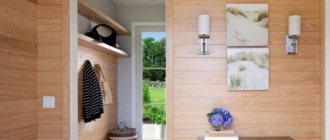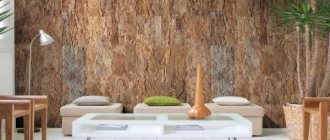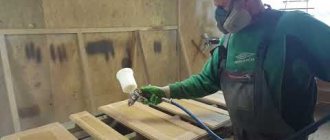MDF panels are a building material intended for finishing premises, cladding the facades of cabinet furniture or walls; it is made from wood chips of low or medium thickness. These parts are considered an environmentally friendly finishing element, since synthetic adhesives are not used in their production, but natural wood resin is used, which reliably fixes all layers of the product and forms a single whole. MDF panels have medium and low density, depending on the number of layers and composition of the wood. Over time, during the operation of these parts, their surface may become scratched, the coating loses its gloss or has defects, as a result, the integrity of the entire panel is compromised, and the appearance of the entire finish becomes unsightly. Any owner in this case is faced with the question: how to update the facade of the panels without completely changing them?
MDF panels on the wall
This article discusses the possibility of painting products such as MDF wall panels, whether it is possible to paint MDF, as well as the process of carrying out such work at home.
Reasons for the formation of defects
There are a number of reasons why painting MDF panels may be necessary, including:
- Mechanical damage to the surface as a result of impact with a sharp object or other material. The top layer of the MDF panel consists of laminated or plain paper with paint applied to it; when exposed to a hard object, the film breaks, which exposes the core of the entire product;
- Paint fading, loss of color brightness. This deformation is caused by exposure to ultraviolet rays and atmospheric air, which contains a small amount of moisture. Over time, the coating becomes matte, loses its shine and original appearance;
- Temperature changes also negatively affect the external condition of the surface of MDF panels, since the internal structure consists of wood, which absorbs moisture from the atmosphere and at the same time swells over the entire area. When the temperature rises, MDF dries out and may crack; moreover, the glue contained in the panel loses its ability due to moisture, which leads to peeling of paper, lamination and shavings.
MDF and water
These causes of deformation lead to an unsightly appearance of the entire surface and disrupt the overall design of the wall. If these defects occur, you can paint MDF panels after first completing a number of preparatory procedures, but you should understand that painting parts with your own hands at home brings a result that differs from processing with paints in production.
Can MDF be painted?
To answer this question, you need to understand why this might be needed at all. The material itself has a medium or low density and over time, for many reasons, various defects may appear on the surface, such as scratches, fading in the sun, or loss of gloss. All this spoils the appearance of the product. And then the owner thinks about how to correct the situation without completely changing the MDF.
There are a number of reasons why painting MDF at home is required:
Any mechanical damage. Any products made from MDF have a thin layer of laminated paper, which can burst upon impact, exposing the core of the product;
Color fading. In conditions where the surface of MDF is constantly exposed to sunlight, it fades. In addition, the surface loses its glossy shine and appearance;
Jumps in degrees also have a negative impact on MDF. This is a material that consists of wood fractions, and wood is known to absorb moisture well. Therefore, an MDF product can become deformed and swell. And, conversely, in dry air, MDF dries out and cracks. At high humidity, the adhesive substance in the material loses its properties, which leads to peeling of paper and shavings.
If you encounter such problems, you can fix it yourself. To properly paint MDF, you need to carry out a number of preparatory work. In addition, you should have the following devices:
- to apply a primer layer and paint to furniture facades, it is best to use a spray gun;
- Brushes with soft but elastic bristles will also do an excellent job. Especially if there is MDF milling;
- For products without milling, a roller is suitable.
MDF primer for painting
MDF painting technology includes several stages. And the first one is the primer. But before it is carried out, it is necessary to prepare the surface, sand it, remove sharp edges and degrease the surface. If there are any cracks, they need to be puttied. After the material has dried, the surface must be sanded again.
How to prime MDF before painting? The primer is carried out in several stages. The first to use is an insulating primer, which is sprayed from a spray gun at a rate of 100 grams per m2. But this applies to non-laminated products. Otherwise, you can skip this step.
This stage is necessary so that the paint or varnish does not absorb and sag after some time. The primer seems to fill in all the small irregularities and depressions. After it dries, the coating needs to be sanded again.
The second layer is white polyurethane primer. Consumption - 150 grams per m2. At the same time, it dries for a long time - about 24 hours.
All this is done with a spray gun, but if you don’t have one, you can also take a brush. The first layer is made along, and the second - across the first.
How can you paint MDF?
Before painting an MDF facade at home, you need to select the right materials for these purposes. It is worth remembering that painting should be carried out at approximately +20C and air humidity of 50-80%. All paints will not be suitable for these works, because MDF is, in fact, wood, and therefore the paint must be designed specifically for this material. This includes:
water-based compositions (water-based). Often used for significant volumes of work;
compositions based on alkyd enamels. The coating is resistant to abrasions, but can easily fade in the sun;
silicone materials. They have water-repellent characteristics and can withstand high temperatures;
polyvinyl acetate materials - suitable only if the product is not subject to heavy loads or damage;
oil-based compositions are moisture resistant;
acrylic-silicone compounds. They withstand damage and also prevent the proliferation of harmful microorganisms;
special paint for MDF facades;
Many also prefer powder painting - it is more durable and the coating is more even.
Any paint for furniture facades and other MDF products must be of high quality and as harmless as possible to humans and the environment. So you can be sure that the product will serve you for a long time and will retain its original appearance.
All this is applied with a spray gun, but if you don’t have one, brushes will do. However, with a spray gun the coating is more uniform and even.
Applying paint
This stage is actually very simple. First you need to prepare the paint material according to the instructions offered by the manufacturer. Next, you need to take your spray gun and set it up so that it sprays the material into small areas. This way you can save paint, and the coloring itself will be of higher quality.
Painting process for MDF panels
Before answering the question of how to paint MDF panels, you need to understand the composition of this product. An MDF board, wall or facade, consists of several layers of compressed paper and sawdust, laminated with a transparent or colored film on the front side. Most often, it is the top layer that is subject to damage and wear, so when planning to update MDF, you need to prepare the specified types of coatings.
In order to prepare MDF panels for painting at home, you will need:
- Sandpaper for preparing the surface and removing gloss or varnish;
- Solvent for degreasing the surface from glue and liquid residues;
- Dry rags or other lint-free cloth.
These materials are necessary for pre-treatment of MDF panels for painting and sealing cracks and scratches on the laminate.
Priming MDF panels
All work must be carried out in accordance with the action algorithm. The first step is to sand the panel with fine sandpaper; this can be done manually or using a pneumatic tool. It is important to follow the varnish removal technology, to prevent overheating of the surface or the formation of large marks on the laminate. The wood-fiber surface is under the decorative film, so when sanding you need to carefully monitor the thickness of the top layer so as not to erase it completely. After this procedure, the coating will no longer shine and will become rough and slightly scratchy.
Next, you need to clean all cracks and chips from dirt and dust, and also clean their edges. All irregularities, if necessary, are smoothed over with a special putty, which forms a single whole with the base of the panel; it also needs to be leveled with sandpaper.
After the surface has been processed and leveled, it must be wiped with a dry cloth and degreased with a chemical solvent, which will displace and evaporate all water and wash away dust and dirt.
The next step is to prime the top coat with a special paint; it has a grainy texture and can be applied using compressed air or a simple brush. It can be used to cover the surface in several layers, with intermediate sanding, until the required smoothness is achieved.
Next, the base paint is prepared, tinted and thoroughly mixed so that all the elements are mixed together. You can paint MDF panels manually or with a special pneumatic gun, but this will require a compressor unit and a moisture-water separator. The composition is applied with smooth movements in two layers: the first - across the main direction, the second - along the entire length of the part. Thus, the formation of smudges and paint sagging is prevented.
The final step will be to treat the top paper-wood layer of the panel with transparent varnish. This procedure is not necessary, but after it is carried out, the surface of the MDF product becomes glossy, its top layer seems renewed, and the appearance of the entire structure is restored.
For your information. It is important to observe the drying intervals for elements between layers of primer, paint and varnish, since otherwise they will curl and crack, and you will have to do all the work again.
Using a spray gun
What are wall panels?
The use of modern finishing materials allows you to finish the room quickly, efficiently and without unnecessary dirt. Wall panels are a functional and aesthetic option for creating a modern interior. Manufacturers offer a wide range of cladding, varying in shape, size and decorative features.
Product performance and cost vary depending on the material. Panels can be made of wood and its processing residues, plastic, glass, gypsum . Artificial slabs are offered with imitation stone, metal, leather, brick. The products are mounted on lathing or special glue.
Varieties
Decorative panels for walls are classified into 3 groups according to their shape:
- Rack and pinion Externally, the installed coating resembles lining. Set products are produced up to 6 m long, but more often you can find 2.2-3 m. The width of each plank is 10-30 cm, thickness - 8-25 mm. The parts are fixed using a tongue-and-groove system. The locking connection allows you to create a single, durable structure. The panels are made of plastic or wood. This type is recommended for small rooms; vertically positioned planks visually increase the space. Horizontal installation reduces the height of the ceilings, but visually lengthens the room. During installation, a starting and finishing strip and additional elements for external corners are used.
Scope of application
Decorative panels are used in the interior of cottages, dachas, and apartments. With their help, the ceiling and walls are decorated, rooms are zoned, columns and partitions are created. Glass slabs are popular as a kitchen backsplash; plastic is used to make a bathroom screen . Cladding is used in office premises, cafes and restaurants, hotels, and public buildings.
How to paint and renew MDF panels
For MDF panels, you can use alkyd or acrylic enamel, but when choosing a paint, you should take into account the type of primer, operating conditions of the panels, and the composition of the top layer. If it is laminated paper with a synthetic, weakly absorbent film, then it would be advisable to use acrylic or water-dispersion enamel. These materials are environmentally friendly and are perfect for interior painting indoors, while the surface of the panel will be renewed and also additionally protected from the moisture of an aggressive external environment.
Thus, if the entire painting technology is followed, the question of whether it is possible to paint MDF panels becomes completely solvable at home.
How to update the lining on the loggia?
Today there are several effective ways to help update clapboard walls: Painting. Applying varnish. ... Before painting and varnishing, you need to prepare the wall covering:
- clean from dirt;
- degrease with an alkaline solution;
- sand with an abrasive wheel or sandpaper;
- coat with antiseptic.
Interesting materials:
How to properly cut onions for pilaf? How were they born or born correctly? How to plant eustoma correctly? How to plant irises correctly? How to plant crocuses correctly? How to plant gooseberries correctly? How to plant sea buckthorn correctly? How to plant petunias correctly? How to plant peonies correctly? How to plant plum trees correctly?
Pros and cons of painting MDF
MDF is painted most often for two reasons:
- the need to protect the material from negative environmental factors;
- decorative purpose - you want to change the color of the MDF board or improve its appearance.
Regardless of the reason for painting, it has a number of advantages:
- The painted element becomes resistant to high temperatures. This means that when using an MDF panel in the kitchen, you can place hot dishes on it.
- The presence of special additives in the paint allows you to obtain facades of an original design: mother-of-pearl, pearl, metallic.
- As a rule, paints intended for MDF do not contain harmful chemicals. This is a big plus, especially if you plan to dye the material at home.
- And finally, painting products can significantly extend their service life.
Of course, painting MDF is not without its drawbacks, of which the following can be highlighted:
- high price compared to film coating;
- possibility of color fading under direct exposure to sunlight.
What to combine with a glossy set?
Whatever you say, a glossy set, regardless of color, will stand out and attract attention.
Glossy MDF painting is undoubtedly an accent in the interior. It is better to surround it with discreet matte surfaces. This applies to the tabletop - it will also be more convenient, but it is especially important for the ceiling and floors.
A glossy set in combination with a glossy ceiling will not look as impressive as gloss on a matte background. The combined facades look interesting - the top is glossy and the bottom is matte. Or, for example, all horizontal surfaces are dark matte, and vertical surfaces are bright gloss.
The combination of a glossy finish with natural materials or their imitation looks interesting. Wooden details or a stone countertop will contrast very favorably with the brightness of the gloss.
Gloss MDF painting is a suitable choice for any modern design. It doesn’t matter whether it’s high-tech, loft, modern or fusion. By choosing the right color you can easily fit such furniture into the interior.
What materials should I use?
Since MDF is a material that consists of wood fiber, it can also be painted with conventional wood paints. However, to get a truly high-quality result and uniform coloring, you will need special formulations, including:
- polyurethane-based primer;
- paint (also polyurethane);
- varnish for MDF (if necessary).
Polyurethane enamel does not contain volatile components and can be used for both interior and exterior use.
Conclusion
Painting MDF can significantly increase its service life, as well as make the product more attractive and resistant to elevated temperatures. Since MDF is a wood material, it can be treated with almost any paints or varnishes for wood (see also the article “Painting MDF furniture facades”).
But to get the best results, you should still use specialized compounds. This is a polyurethane primer, as well as polyurethane enamel and varnish on MDF. They allow you to create a hard and wear-resistant coating that can have a wide variety of colors.
The video in this article will give you more information on this topic.
Dyeing technology
The process of painting MDF with colored polyurethane enamels includes several stages:
- grinding;
- primer;
- direct painting;
- drying.
Grinding
For good adhesion of the paint and varnish coating, it is necessary to sand the products being processed, be it facades or wall panels. For this we use:
- dry sandpaper;
- Scotch Brite - a soft, fine-grained abrasive;
- Underground grinding machines.
If the product is small, then sandpaper on a foam rubber base with a gradation of P220-P280 is used. For flat surfaces, 700 series sanding mats with fine-grained abrasive are used. The same materials will help remove excess primer and fill in scratches before painting.
The surface directly on which the paint will be applied is cleaned. After cleaning, the surface must be degreased with anti-silicone.
putty
MDF is prepared carefully for painting; sanding alone will not get rid of it. If there are visible flaws (cracks, dents), then the surface in these areas must be puttied, thereby leveling the surface.
For puttying, acrylic putty for wood is best suited; it should be applied and smoothed with a special rubber spatula.
Primer
For flat products it is better to use universal white polyurethane primer LBR30. The content of a large amount of resin in it gives a minimal tendency to shrinkage. Suitable for matte and glossy finishes. For the latter, where every defect is visible on the surface, the preparation requirements are an order of magnitude higher. The best results are obtained by using polyester primers.
Before painting the panels, they must be thoroughly prepared. First make a working mixture. To do this you need to take:
- primer LBR 30 – 100 parts by weight;
- hardener LNB 77 – 40 parts by weight;
- thinner LZC 1051 – 10 parts by weight.
All these components must be mixed together and the first layer of primer must be applied to the surface to be painted using a gun with an upper tank. Nozzle diameter 1.8 mm, air pressure 2-3 atmospheres. The material consumption should be 120 g per 1 m2. The optimal thickness of the resulting film is 120 microns. To completely complete the shrinkage process, the soil should be dried for 12 hours.
Before painting the product, it will need to be treated with abrasive again. For gloss, an emery tool with a finer grit is additionally used. After this, the surface will be prepared, and paint for MDF panels can be applied.
In the video: priming and sanding MDF.
Painting
You can paint wall panels with a brush, roller or spray gun. The room temperature should be about +20°C, air humidity - within 50-80%. Can be painted with matte or glossy enamel. But first you need to prepare working compositions. For matte enamel take:
- 100 parts by weight of enamel;
- 50 parts by weight of hardener;
- 30 parts by weight of thinner.
For glossy enamel, 70 parts of hardener are taken. The remaining components are in the same quantities. For gloss you should always use a slow thinner that will ensure good flow.
Painting of MDF panels should be done in a relatively spacious room, if these are internal structures (for example, facades or wall elements). The outside of the house should be finished in the warm season. The enamel consumption should be approximately 150g/m2. Medium density fiberboard or MDF dries completely in 24 hours.
To obtain a glossy finish, polishing should be done after 3 days. By this time, all polymerization processes will be completed. Using special additives on the surface of the product, you can create mother-of-pearl, metallic effects, and obtain corrugated waves.
Wet
MDF panels can be painted with alkyd or polyurethane enamel, as well as powder mixtures. Wet technology involves the use of a sprayer with appropriate pressure. If the paint is applied in two layers, intermediate sanding is necessary. The thickness of the layers is no more than 120 microns.
Painting surfaces must be free of small debris, dust, and insects. If they get in, they should be removed in a timely manner using a tool such as tweezers. Smudges formed on the painted surface after drying are removed with a stationery knife or fine-grained sandpaper.
Powder
Is it possible to paint MDF in another way? Yes, there are special powder mixtures that are applied to the work surface with a sprayer. After this, the product is subjected to high temperatures until the paint completely melts. This method provides for obtaining an almost perfectly smooth surface.
Powder coating technology involves spraying dry microscopic particles onto the surface.
Drying
You can paint MDF panels using any method. Drying completes any finishing process. It is carried out subject to certain conditions:
- ambient air temperature no more than 50°C;
- relative humidity less than 80%.
The duration of the final stage depends on environmental conditions. Can range from 5 hours to a day. Painted MDF board will dry faster at lower temperatures and air humidity.
Regardless of what you can use to paint wall panels, following the steps and conditions of the technological process will allow you to get a rich color, a smooth surface, and will save time and costs. It is better to automate all the work using special paint and varnish equipment.
How to paint MDF correctly (2 videos)
What you need for work (20 photos)
Painting MDF boards is a very labor-intensive procedure that will require compliance with technology and many rules. It is immediately worth noting that such work takes a long time, it may take more than one week. In any case, you can do everything yourself and still get the necessary decorative surface.
Features of MDF
Most of those who plan to build a country house, make repairs or make built-in furniture themselves are interested in the question: “What is the difference between MDF and chipboard?” In appearance they are very similar, but the production technologies are different and, accordingly, the performance qualities are also different.
For comparison, we offer you a small instruction:
| Differences | Chipboard | MDF |
| Raw materials for production | Large shavings of low-value wood | Fine sawdust is a waste product from the wood processing industry, as well as wood intended for logging. |
| Difference in technology | Pressing under hot steam. Formaldehyde is used in production - a very toxic substance. | Pressing under high pressure and temperature. Paraffin and wood humus, called lingin, are used as a binder. So, MDF is an environmentally friendly material. |
| Application | Only in dry rooms. As a rule, these are floors, partitions, built-in furniture. It is not recommended to use in bedrooms and children's rooms. | Can be used in rooms with humidity levels up to 80%. Since MDF contains no toxic substances, it can be used for finishing premises for any purpose. |
Since MDF has a denser structure and is able to withstand higher levels of humidity, it practically does not deform over time. That is why today factories use only MDF in the production of cabinet and upholstered furniture. The technology for painting MDF and chipboard facades is similar, and we will talk about it in a separate chapter.
Note! In this case we are talking about furniture and built-in interior facades. Neither one nor the other material is used for finishing external walls! The facades of houses are sheathed with OSB boards, which are completely impenetrable to moisture. They obtain such properties due to the presence of polymer resins in the composition.
Medium density fibreboards, namely MDF, are in demand not only in the furniture industry, but also in the production of interior finishing materials. In addition to wall and ceiling panels, these are also molded products: slats, platbands, MDF baseboards for painting.
Why do this?
Many people wonder: is it possible to paint MDF at home, and why is this necessary? The answer to the first part of the question is yes. Indeed, you can paint the panels yourself. But it’s worth making a reservation right away: if you don’t have a spray booth at hand, the result is not always ideal. The coloring procedure is necessary for the following reasons:
- Painted elements become more resistant to high temperatures and humidity. Therefore, they can be used in the kitchen and bathroom, where they can fulfill different roles.
- By decorating, it is possible to diversify a dull interior and refresh the appearance of the room. The shade is chosen based on the design ideas.
- Painting MDF panels is also necessary in order to extend their service life.
Painting MDF allows you not only to diversify a boring interior, but also to extend the service life of the product
Of course, this option also has some disadvantages. For example, this procedure is sometimes much more expensive than using decorative films. In addition, the surface becomes prone to fading.
Types of varnishes
Instead of painting, you can choose varnish. To reliably varnish MDF, you need to apply several layers and wait until it dries completely each time. The process will take a long time and require effort.
If you still decide to choose a varnish, then pay attention not only to its cost and composition, but also to wear resistance, resistance to humidity, and high temperature. To coat MDF boards at home, you can use several different types of varnishes.
The cheapest compositions in this segment are alcohol-based and have a short drying time (up to half an hour), that is, they are quick-drying. Traditional inexpensive varnishes include oil-based varnishes, which not only give a beautiful appearance to surfaces, but also effectively protect them from moisture.
Note! For coating MDF countertops, an excellent choice would be two-component epoxy varnishes, which are characterized by increased resistance to impact.
Acrylic varnishes are good because they are odorless, do not emit toxic substances, and are not washed off or diluted with water. Another popular option is polyurethane varnish. It is characterized by enviable wear resistance and good adhesion to wood-based materials.
As for those cases where further polishing of MDF products is expected, nitrocellulose varnishes are the best option.
Selection of materials for painting
In principle, all paints for MDF are selected taking into account the composition of the material. And this is, first of all, a fine wood fraction, which means that paint solutions for wood are suitable for the job. But to obtain a truly high-quality coating, it is advisable to use special mixtures.
When choosing materials for painting MDF, you should pay attention not only to the color, but also to the purpose of the paint
Polyurethane enamels
This material should be preferred for the following reasons:
- The coating is wear-resistant and can withstand exposure to household chemicals.
- The solution does not have an unpleasant odor, which makes it possible to carry out work in cramped home conditions.
- The mixture can be applied using a sprayer, roller and brush.
- Painting MDF with enamel is done independently; this procedure does not require professional skills.
Naturally, when choosing this material, they pay attention to the manufacturer. It should be a well-known brand that is sold in specialized stores. When purchasing a product from an unknown manufacturer, there is a high probability of getting a fake.
Advice! If it is not possible to select a polyurethane composition, then pay attention to alkyd enamels and paints (oil and acrylic).
When choosing paint, you need to pay attention to the manufacturer
How to coat fiberboards
A special varnish is used to treat surfaces. It helps create a smooth coating that is resistant to mechanical and chemical influences. The treated surface can be glossy or matte. Gloss is the result of using varnish based on synthetic resins. A water-based acrylic coating gives a matte effect.
MDF coating varnish is a two-component substance. Before starting work, you need to add a hardener to the base. Typically this varnish is odorless.
The prepared working mixture should be used within two to three hours. The coating can be applied using a spray or a regular brush.
Like all finishing materials, varnish for MDF panels has its advantages and disadvantages. In addition to the fact that it has good moisture and heat resistance, it protects the material from the appearance of fungus and harmful microorganisms, creating a dense film on the surface of the slab. The varnished surface is easy to clean, does not wear out, and retains its good appearance for a long time. By covering a product, for example a door, with a varnish composition, you can emphasize the texture of the base and give it a certain shade.
If the texture of a wooden product needs to be hidden or given a different color, MDF is often painted.
The disadvantages of varnish coating include its fire hazard, drying time, fairly high price and increased consumption.
When choosing a varnish to coat MDF panels, you need to pay attention to some parameters:
- drying time should not exceed 72 hours;
- dust drying time – no more than 15 minutes;
- operating temperature – from +5 to +25 degrees;
- the composition of the varnish should contain no more than 20% of volatile substances;
- consumption no more than 0.5 kg per square meter.
Stages and technology of painting
The procedure for painting MDF with your own hands is carried out in several stages. They can be divided as follows:
- Grinding.
- Putty.
- Padding.
- Coloring.
- Varnishing (patination).
Completing each stage is a guarantee that the result will turn out as intended.
Grinding
Work begins with grinding the surface. This is a rather labor-intensive task that must be performed carefully.
The panels are sanded with sandpaper with grit from 120 to 240 units. The process is performed in several stages and using different materials. Everything must be done very carefully, without staying long in one area. This procedure is carried out in order to remove small irregularities, as well as remove the fine lint that covers the entire surface.
The MDF sanding procedure allows you to get rid of small irregularities on the surface of the board
On a note! If there are milled areas on the front side, it is better not to touch them. There is a good chance that the sandpaper will smooth out the corners of the design.
Puttying
Puttying MDF for painting has the goal of correcting the existing shortcomings of the panel. It happens that during grinding or due to improper storage, cracks or dents appear on the surface. To hide them, putty is used. Of course, if there are no such problems, then this stage is skipped.
The technology itself looks like this: the acrylic mixture is carefully applied to the desired area and leveled with a rubber spatula. After drying, be sure to sand it.
Padding
It is better to prime the surface of an MDF board using a spray gun, then the primer layer will lay down more evenly
This stage is mandatory. It is conventionally divided into two processes:
- Applying the first layer of primer This is done using a spray gun, so the room and place for work are prepared. It is better to cover other items with cellophane film in advance.
- The mixture is sprayed over the entire surface of the panel in an even layer. This is done in order to raise the remaining pile and reduce the absorption of the base materials.
- Next, when the slab is dry, it is sanded using fine sandpaper.
- The second layer is applied in order to consolidate the result and remove remaining blemishes.
Coloring
Can MDF be painted with a brush and roller? Yes, but this should be done very carefully. There is a high probability that stains and streaks will remain on the surface. Therefore, it is best to use a spray gun.
The technology itself resembles priming. The paint is applied in several layers, each of which is pre-dried. It is important to achieve an excellent result, so the mixture begins to be sprayed from the milled areas to the edges, and then passes along and diagonally. It is much more convenient to paint smooth panels.
To paint MDF you can use brushes and a roller, but to obtain an even layer it is better to use a spray gun
On a note! To understand in more detail the drying time of the solution and its quantity, you must carefully study the manufacturer’s instructions. And also select the desired operating mode for the sprayer.
Necessary tools for varnishing
The material sets quickly, so you need to prepare everything you need to work with it:
Small tool for varnishing MDF.
- container for creating the mixture (if a two-component composition is used);
- a construction mixer or a special attachment for an electric drill;
- spray bottle, brushes of different sizes (narrow and medium width), roller;
- devices for making ornaments: sponge, construction tape, stencil;
- solvent, when you need to dilute the varnish to obtain the required consistency;
- sandpaper of different grits for sanding the surface.
When choosing, the configuration of the structure being processed is also taken into account; if there are difficult areas, prepare a small brush. It is also used when the main tool is a spray gun or roller. A narrow brush will help to treat hard-to-reach areas and small details.
During work, use protective equipment: rubber gloves, a respirator. When MDF board is treated with varnish containing a high percentage of volatile toxic components, the respiratory tract is protected. Otherwise, the risk of poisoning by toluene and xylene vapors increases.
If you want antique
If there is a desire to give the surface a more expressive look, to age it a little, then they resort to patination. It is advisable to do this when there are drawings and patterns.
Patina is applied in this way:
- walk over the selected area with a sponge soaked in the mixture;
- leave until completely dry;
- the painted area is sanded;
- proceed to the final stage.
You can create the effect of artificial aging yourself by resorting to patination of the surface
Choosing paint
Remember that unless you sand and prime your plastic product, you should only purchase paints that are specifically formulated for painting PVC.
- Choose a shade. To do this, you can use the NCS, RAL or Monicolor catalogs, where there is such a large selection that finding a suitable color will not be a problem.
- Determine which items and in what quantity will need to be painted. This will make it possible to calculate the volume of paint for a certain area.
- Tint to the required shade at least 60 minutes before starting work. The paint will be tinted according to a special recipe with the addition of pigments. The selected shade will be as close as possible to the color in the catalog. If possible, check the viscosity using a VZ-6 viscometer and adjust, if necessary, by adding pre-purified water.
Paint for rigid PVC products
Coloring
The process should be carried out in one layer at room temperature without first applying a primer. When using a sprayer, the coating will be of better quality.
You can also apply the paint with a brush or roller. The material dries in about 8 hours, depending on the temperature, but it can be fully used only after 72 hours.
Tip: if necessary, you can apply a second coat, but only when the previous one is completely dry.
If you use a gun for painting, make sure that the temperature of the paint, it and the plastic corresponds to the working room - not lower than 18°C, humidity should not exceed 80%. It must also be dry and clean. It is recommended to apply with a working pressure of 2-2.5 atmospheres, nozzle size - 1.6-1.8 mm.
The desired film thickness is at least 60 microns, otherwise it will affect the adhesion strength to the base. If the layer thickness is more than 120 microns, the drying time will increase and this will affect the decorative effect of the coating.
Advice: there are enough items in the room that could be damaged during a fire. To protect them, use modern fire-retardant metal paints Polistil, which are diluted with water.
Polyurethane PVC paint
How to dry
Drying of painted surfaces made of ABS plastic occurs at temperatures exceeding 40 °C. They should be placed in a heated dryer no later than 5-10 minutes after painting.
If the wet film thickness is 80–120 microns, the temperature is 50°C and the relative humidity is 65%, drying will last approximately 2-3 hours. There is no need to immediately check the degree of adhesion; it is better to wait 24 hours; complete polymerization occurs in 5-7 days.
Remember that the drying time may increase significantly due to the large thickness of the wet layer, lower temperature, larger dimensions of the product and high humidity.
When storing finished plastic products, they must be protected with film or paper, protected from friction and impacts on the painted surface. Also, they should not be exposed to moisture and freezing temperatures for a long time until complete polymerization.
Varnishing
The procedure is performed according to the instructions:
- The varnish is prepared for use.
- The first layer is applied at the rate of about 150 grams per square meter.
- After waiting for the first layer to dry well, apply a new layer.
- Repeat the drying process.
- Final sanding begins. First, sandpaper with a coarse grain is passed over the surface, then a finer one is used. To avoid lumps forming, spray the area with water.
- The panel is left for several days (from 4 to 7) and polished. For this it is better to use a power tool.
There are many tips on how to properly paint MDF. The main thing is to follow a clear plan and be careful.
The corridor is lined with MDF panels in a light wood look from floor to ceiling. The thickness of the panels is about 5 mm, I don’t see any film on top, it looks like a regular paper and cardboard layer on top. We touched it a little with our hands, decided to wash it with a damp dish sponge, rubbed it here and there a dozen times and rubbed it until there was a light spot in the middle of the wall, it would be okay if I stopped, otherwise I rubbed it in a couple more places. The first thought was to cover the entire corridor with stain or varnish, maybe darken it a little color, it doesn't matter. I'm leaning towards painting with a roller. What can you guys use to paint over worn areas and preserve the overall color if possible? Maybe varnish with a tint. Is it possible to cover MDF with it? I don’t understand how I did this. Thanks for the advice and Happy New Year everyone.
Choosing paint
Remember that unless you sand and prime your plastic product, you should only purchase paints that are specifically formulated for painting PVC.
- Choose a shade. To do this, you can use the NCS, RAL or Monicolor catalogs, where there is such a large selection that finding a suitable color will not be a problem.
- Determine which items and in what quantity will need to be painted. This will make it possible to calculate the volume of paint for a certain area.
- Tint to the required shade at least 60 minutes before starting work. The paint will be tinted according to a special recipe with the addition of pigments. The selected shade will be as close as possible to the color in the catalog. If possible, check the viscosity using a VZ-6 viscometer and adjust, if necessary, by adding pre-purified water.
Paint for rigid PVC products
Coloring
The process should be carried out in one layer at room temperature without first applying a primer. When using a sprayer, the coating will be of better quality.
You can also apply the paint with a brush or roller. The material dries in about 8 hours, depending on the temperature, but it can be fully used only after 72 hours.
Tip: if necessary, you can apply a second coat, but only when the previous one is completely dry.
If you use a gun for painting, make sure that the temperature of the paint, it and the plastic corresponds to the working room - not lower than 18°C, humidity should not exceed 80%. It must also be dry and clean. It is recommended to apply with a working pressure of 2-2.5 atmospheres, nozzle size - 1.6-1.8 mm.
The desired film thickness is at least 60 microns, otherwise it will affect the adhesion strength to the base. If the layer thickness is more than 120 microns, the drying time will increase and this will affect the decorative effect of the coating.
Advice: there are enough items in the room that could be damaged during a fire. To protect them, use modern fire-retardant metal paints Polistil, which are diluted with water.
Polyurethane PVC paint
How to dry
Drying of painted surfaces made of ABS plastic occurs at temperatures exceeding 40 °C. They should be placed in a heated dryer no later than 5-10 minutes after painting.
If the wet film thickness is 80–120 microns, the temperature is 50°C and the relative humidity is 65%, drying will last approximately 2-3 hours. There is no need to immediately check the degree of adhesion; it is better to wait 24 hours; complete polymerization occurs in 5-7 days.
Remember that the drying time may increase significantly due to the large thickness of the wet layer, lower temperature, larger dimensions of the product and high humidity.
When storing finished plastic products, they must be protected with film or paper, protected from friction and impacts on the painted surface. Also, they should not be exposed to moisture and freezing temperatures for a long time until complete polymerization.
